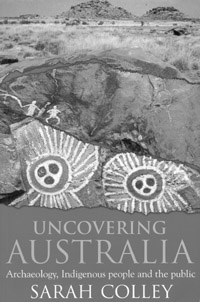Book Review
Uncovering Australia: Archaeology, Indigenous People, and the Public
By Sarah Colley. Washington, DC, and London: Smithsonian Institution Press, in association with Allen & Unwin, Crows Nest, New South Wales, Australia, 2003; 251 pp., illustrations, notes; paper $24.95.
 |
This book is about the practice, politics, and ethics of archeology in Australia. Aimed at nonspecialists, but written to be of interest to archeologists and cultural heritage managers, it will also interest those working in the United States and Canada, as there are many parallel issues. Factors operating in Australian archeology today include the "relationship between 'science' and Indigenous rights; community-based action against development which threatens important cultural places; and the role of government and the media in mediating interactions between different interest groups."
Throughout the book, Colley uses case studies to illustrate her points. The examples may not be well known outside of Australia, but demonstrate how particular cases changed relationships among archeologists, Indigenous people, the public, government, environmentalists, and the media.
Colley provides the reader with a professional context by summarizing archeological practice and the basics of cultural heritage management. In Australia and many other countries, the term cultural resource management has been replaced by the term cultural heritage management in order to include a much broader meaning. Heritage includes intangible as well as tangible heritage. In addition, the separation of cultural and natural heritage makes little sense to Indigenous societies. As in other countries, focusing on cultural landscape and landscape archeology breaks down this divide somewhat.
Three chapters center on relationships between archeologists and Indigenous people, covering issues of repatriation and Indigenous rights and negotiations over archeological research. In some cases archeology is in direct disagreement with Indigenous beliefs. Indigenous people may perceive archeology as both a physical and spiritual threat. However, archeology may also bring tangible benefits and Colley provides examples of success stories of archeologists and Indigenous people working together. Archeologists need permission to conduct archeological research (as opposed to compliance studies) on Indigenous places in Australia and therefore need to negotiate with communities. When an archeologist approaches a community and seeks permission to conduct a survey or excavation, the community can decline permission, suggest changes to make the work more relevant, or give permission, perhaps with certain conditions. As in other countries, questions arise about who represents the community.
Some of Colley's case studies illustrate that relationships are different between archeologists and Indigenous peoples depending on whether the context is research or consulting work. Archeological work is more likely to take place in the latter context. Australian planning legislation requires considering archeology as part of environmental assessments. As in the United States, cultural values must be taken into account but the presence of heritage resources does not necessarily stop development.
In Australia as in the United States, the legislated process defines the archeological record in terms of artifacts, groups of artifacts, and spatially bounded sites, and promotes a piecemeal approach focused on small, disconnected parts rather than on region- or landscape-based approaches. Landscape approaches have long been of interest in the United Kingdom and other parts of the world. In the United States, the regional approach has been available for decades and yet restricted by the site-based approach reified in cultural resource management legislation.
There has been a trend toward providing Indigenous people with more legal control over their own places, but in the current political climate, Colley thinks that the tide may have turned against Indigenous interests. In spite of this, Colley expects increased Indigenous coordination and control of heritage assessment work. Archeology of some kind will continue, but numerous questions persist, such as who will do the work. Will it be members of the community and will they have archeological training?
Colley considers archeology in a broader public context. In discussing archeology and the public, it is clear that not much information is available on public perceptions of archeology in Australia. (Contrast this with the good baseline data collected in the United States by Harris Interactive. The study is available online at http://www.nps.gov/archeology/pubs/harris/index.htm). Discussion here is based on public misconceptions about the "romance and adventure" of archeology. Colley refers to Peter Hisock's useful distinction between "pseudo-science," which uses scientific terminology and cites "evidence," and "New Age" archeology, which rejects conventional methods and relies on revelation rather than examination. United States practitioners of cultural resource management will recognize the situation in this statement: "Proponents of both pseudo-science and New Age archaeology commonly accuse scientists, archaeologists and the government of ignoring them and perpetuating a cover-up about the True meaning of archaeological sites and what Really happened in the past."
Colley's concluding chapter on archeology, Indigenous Australia, and postcolonialism attempts to explore connections between archeological practice and knowledge in the contexts of postcolonialism and postmodernism. The author explicitly acknowledges the discordance of modern society and the loss of confidence in science and academic knowledge in the postmodern age. She argues for considering other social values when deciding significance of a place, particularly in the wake of colonialism where Indigenous people and their culture were devalued. In this postcolonial context, the politics of race influences archeology in Australia.
Colley states clearly that this is not an archeology book. Instead it is a book about archeology in social context and is intended to provoke discussion. It should succeed in that intention, not only in Australia but in any country with both Indigenous and immigrant populations where cultural heritage or cultural resource management is practiced.
Barbara Little
National Park Service
